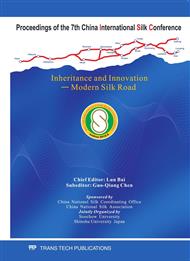p.214
p.220
p.224
p.230
p.236
p.242
p.247
p.253
p.258
Inflammatory Response of Native Silk Fibroin Powder/Polyurethane Composite Membrane Containing Aspirin In Vivo
Abstract:
regeneration silk fibroin particles prepared through the dissolving-regeneration route do not fulfill many desired requirements for bio-related applications, due to their partial solubility in water. So, Native silk fibroin powder (NSFP) was prepared by mechanical method to instead of regeneration silk fibroin particles. The goal of this paper is to evaluate the inflammatory response of polyurethane/NSFP composite membrane containing aspirin implanted in mice. The polyurethane/NSFP composite membranes containing aspirin were fabricated by coagulation technique at 30°C. The composite membranes were embedded in mice for 1 weeks and inflammatory response of composite membranes in mice was studied. Inflammatory cells accumulation occurred around implanted polyurethane/NSFP composite membrane, but was reduced significantly in composite membrane containing aspirin. The results indicated that the aspirin released from composite membrane of polyurethane and NSFP could suppress the replication of inflammatory cells and prevent the entering of cells into composite membrane.
Info:
Periodical:
Pages:
236-241
Citation:
Online since:
January 2011
Authors:
Price:
Сopyright:
© 2011 Trans Tech Publications Ltd. All Rights Reserved
Share:
Citation:


